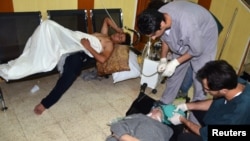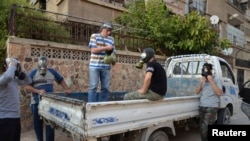LONDON —
Even those who survived the suspected chemical weapons attack in Damascus - and many hundreds didn't - may have life-long disabilities and health problems for which there are few effective treatments.
The death toll from the incident, the latest grisly episode in Syria's two-and-a-half-year civil war, could well rise in coming days as doctors and other health workers who suffered secondary exposure via the direct victims start to succumb to the agent's poison.
Antidotes and emergency treatments do exist for patients suffering the immediate effects of poisoning by a nerve agent - something many experts fear happened to the thousands affected in rebel-held areas of the Syrian capital on Wednesday.
But if no help comes within the first hour or so, the chances become slim that an antidote drug like atropine or oxime, or the sedative diazepam, will do much good.
“[Treatment] needs to be immediate. The damage is done very quickly,” said Ray Zilinskas, a chemical and biological weapons expert at the Monterey Institute of International Studies in the United States.
“Longer term, the major risk is the result of significant restricted breathing,” which could also lead to brain damage, said Alastair Hay, a professor of environmental toxicology and chemical weapons expert at Britain's Leeds University.
Sarin
Source: CDC
One breath could be deadly
Nerve gasses are the most potent and deadly of the known chemical agents. “They are rapidly lethal and are hazardous by any route of exposure,” said Sharon Ruetter of the U.S. Army Edgewood Chemical Biological Center in Maryland.
In a review of chemical weapons hazards in the Environmental Health Perspectives journal, Ruetter said it was theoretically possible to release nerve gasses in high enough concentrations that “one breath would be incapacitating or deadly.”
Nerve gasses include tabun, soman and sarin - the agent experts think is most likely to have been used in Syria.
They interfere with transmissions between nerves, or between nerves and muscle cells, causing muscle weakness or paralysis, including paralysis of the diaphragm and heart. They also cause seizures, loss of body control, restricted breathing, sweating, profuse nasal and lung secretions and constricted pupils.
“With the number of casualties we've seen - the figures I'm seeing at the moment are up to 2,000 dead - and the sorts of symptoms, the rapidity of death... the only plausible explanation is a chemical weapon,” said Hamish de Bretton-Gordon, the former commander of the chemical, biological and nuclear counter-terrorism unit at Britain's defense ministry.
“If it is a chemical weapon, it's most likely to be a nerve agent - and we know that sarin has been used in the past in Syria. We know that Assad has very large stockpiles of sarin, and a delivery of sarin would create these kinds of casualties.”
Hay said that from pictures and videos he'd seen, nasal and lung secretions - signs consistent with nerve gas poisoning - were “very evident in many of the victims.”
Antidote stockpiles?
Then there's the question of whether the antidote is available - and if so, in what quantities.
If the victims - whose writhing bodies and agonized faces shocked the world when Syrian activists published pictures and videos - did suffer a nerve agent attack, then atropine would be the treatment of choice.
A generic medicine, it is used in anesthesia as a premedication, in emergency situations or during surgery to make the heart beat faster, and to reverse the effects of poisons that make people hyper-salivate, or foam at the mouth.
Troops at risk of chemical weapons attacks often carry atropine auto-injectors to administer into thigh muscles.
Since it is a core medicine on the World Health Organization's “Essential Drugs List” - a list of minimum medical needs for any basic healthcare system - hospitals in Syria should have it, but may not have enough to treat a large number of people quickly.
“We have emergency [atropine] stockpiles here in the United States that could be accessed in a short time - and most industrialized countries would be the same,” said Zilinskas.
In Syria, while most hospitals should have small amounts when they are functioning properly, the fear now is that supplies will be severely limited, and that any stockpiles are most likely to be held by the military.
“The question is how quickly would the military share? How quickly would they get it to victims?” said Zilinskas. “It doesn't do much good if it arrives two or three hours later.”
The death toll from the incident, the latest grisly episode in Syria's two-and-a-half-year civil war, could well rise in coming days as doctors and other health workers who suffered secondary exposure via the direct victims start to succumb to the agent's poison.
Antidotes and emergency treatments do exist for patients suffering the immediate effects of poisoning by a nerve agent - something many experts fear happened to the thousands affected in rebel-held areas of the Syrian capital on Wednesday.
But if no help comes within the first hour or so, the chances become slim that an antidote drug like atropine or oxime, or the sedative diazepam, will do much good.
“[Treatment] needs to be immediate. The damage is done very quickly,” said Ray Zilinskas, a chemical and biological weapons expert at the Monterey Institute of International Studies in the United States.
“Longer term, the major risk is the result of significant restricted breathing,” which could also lead to brain damage, said Alastair Hay, a professor of environmental toxicology and chemical weapons expert at Britain's Leeds University.
Chemical Weapons Believed to be in Syria
Chemical Weapons Believed to be in SyriaSarin
- Man-made nerve agent originally developed as a pesticide
- Used in 1995 Tokyo subway attack
- Highly toxic odorless, tasteless, colorless liquid
- Exposure can be by inhalation, ingestion and skin absorption
-
People can recover with treatment from moderate exposure
- Man-made nerve agent
- Odorless and tasteless
- Most potent of all nerve agents
- Slow to evaporate; can last for days on objects
- People can be exposed through skin contact or inhalation
-
People can recover with treatment from moderate exposure
- Causes blistering of the skin and mucous membranes
- Sometimes odorless, sometimes smells like garlic, onions or mustard
- Used in World War One
- Exposure can be by inhalation, ingestion or skin contact
- Vapor released in the air can be carried long distances by wind
- Exposure is not usually fatal
Source: CDC
Nerve gasses are the most potent and deadly of the known chemical agents. “They are rapidly lethal and are hazardous by any route of exposure,” said Sharon Ruetter of the U.S. Army Edgewood Chemical Biological Center in Maryland.
In a review of chemical weapons hazards in the Environmental Health Perspectives journal, Ruetter said it was theoretically possible to release nerve gasses in high enough concentrations that “one breath would be incapacitating or deadly.”
Nerve gasses include tabun, soman and sarin - the agent experts think is most likely to have been used in Syria.
They interfere with transmissions between nerves, or between nerves and muscle cells, causing muscle weakness or paralysis, including paralysis of the diaphragm and heart. They also cause seizures, loss of body control, restricted breathing, sweating, profuse nasal and lung secretions and constricted pupils.
“With the number of casualties we've seen - the figures I'm seeing at the moment are up to 2,000 dead - and the sorts of symptoms, the rapidity of death... the only plausible explanation is a chemical weapon,” said Hamish de Bretton-Gordon, the former commander of the chemical, biological and nuclear counter-terrorism unit at Britain's defense ministry.
“If it is a chemical weapon, it's most likely to be a nerve agent - and we know that sarin has been used in the past in Syria. We know that Assad has very large stockpiles of sarin, and a delivery of sarin would create these kinds of casualties.”
Hay said that from pictures and videos he'd seen, nasal and lung secretions - signs consistent with nerve gas poisoning - were “very evident in many of the victims.”
Antidote stockpiles?
Then there's the question of whether the antidote is available - and if so, in what quantities.
If the victims - whose writhing bodies and agonized faces shocked the world when Syrian activists published pictures and videos - did suffer a nerve agent attack, then atropine would be the treatment of choice.
A generic medicine, it is used in anesthesia as a premedication, in emergency situations or during surgery to make the heart beat faster, and to reverse the effects of poisons that make people hyper-salivate, or foam at the mouth.
Troops at risk of chemical weapons attacks often carry atropine auto-injectors to administer into thigh muscles.
Since it is a core medicine on the World Health Organization's “Essential Drugs List” - a list of minimum medical needs for any basic healthcare system - hospitals in Syria should have it, but may not have enough to treat a large number of people quickly.
“We have emergency [atropine] stockpiles here in the United States that could be accessed in a short time - and most industrialized countries would be the same,” said Zilinskas.
In Syria, while most hospitals should have small amounts when they are functioning properly, the fear now is that supplies will be severely limited, and that any stockpiles are most likely to be held by the military.
“The question is how quickly would the military share? How quickly would they get it to victims?” said Zilinskas. “It doesn't do much good if it arrives two or three hours later.”














